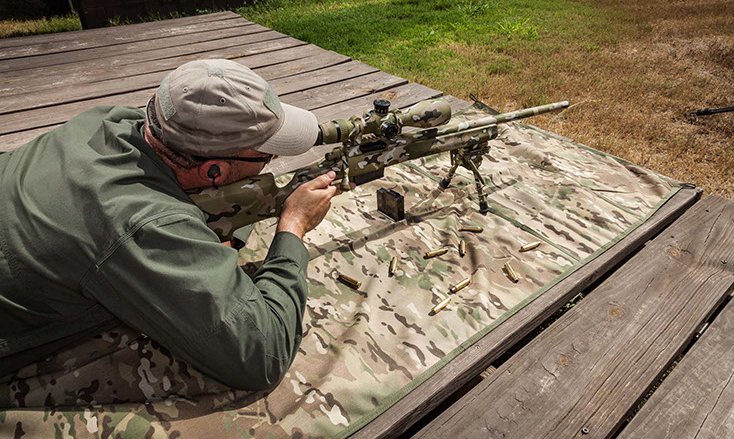We may earn revenue from the products available on this page and participate in affiliate programs. Learn More ›
The rapid-fire drill from last week familiarizes a shooter with the rifle’s mechanics and reinforces shooting under pressure while maintaining proper form.
But, as any experienced outdoorsman will tell you, the goal is to have our hunts be “one shot, one kill” affairs.
The one-dot drill reinforces this. Set up a target at 100 yards that consists of a series of solid black dots in five rows of five. The size of the dots is up to you. If you’re shooting from the prone position with a very accurate rifle, make them one inch in diameter. For less accurate rifles, increase the size of the dots going up to 2.5 inches in diameter.
To do the drill, start with your rifle set up on its bipod or whatever rest you’re using with you standing behind the rifle. At the “go” signal, drop down, get into position and fire five shots, placing one shot on each dot in one of the rows.
The first time you do the drill, give yourself 30 seconds to complete it. As you get more comfortable, decrease the amount of time. With a little practice, you should be able to get off five shots (and make five hits) in less than 20 seconds.
Here are the keys to success:
1. Proper form
In order to make successive shots you need to address the rifle correctly. Get square behind the rifle, with the barrel of the rifle forming a 90-degree angle with an imaginary line drawn between your shoulders. Place a moderate amount of pressure with your shoulder into the recoil pad. If you’re shooting off a bipod, that pressure should take up the slack in the bipod’s legs. Rest your cheek lightly against the stock so that you’re make solid contact with the stock but without pushing your face against it.
The point of all this is two-fold. First, your shots will be more accurate because you’re not putting any negative inputs with your body into the rifle. Second, this encourages superior recoil management, meaning the rifle will move straight backwards and not jump to one side or another, allowing you to see the target, watch your bullet impact, and be in position for the next shot.
2. Trigger control
All those dry-firing drills you started in week one will pay dividends when shooting under a time constraint. A smooth, even press of the trigger straight backwards will make you more accurate. If you are consistently throwing shots to one side of the dot or the other, that’s an indication of issues with trigger control.
3. Follow through
Good follow through depends on mastering both proper form and good trigger control. The best way to encourage good follow-through is to make it your goal to keep your eyes open and watch the bullet until it hits the target, while at the same time keeping the trigger pressed to the rear.
Next week, we’ll up the stress level by adding some cardio to these drills. If you haven’t seen Jimmy Herman’s posts via Montana Rifle Company on how to get in shape for this season, check them out here—because this is where it all comes together!
Miss a week? We’ve got you covered:
Week 1: Dry Fire Drills
Week 2: How to Really Zero Your Rifle
Week 3: Rapid Fire Drills
